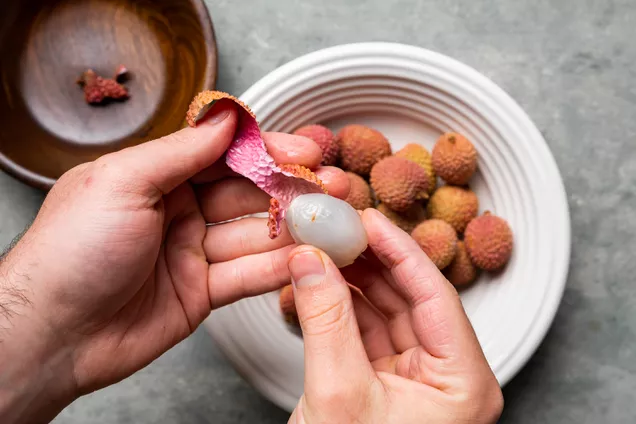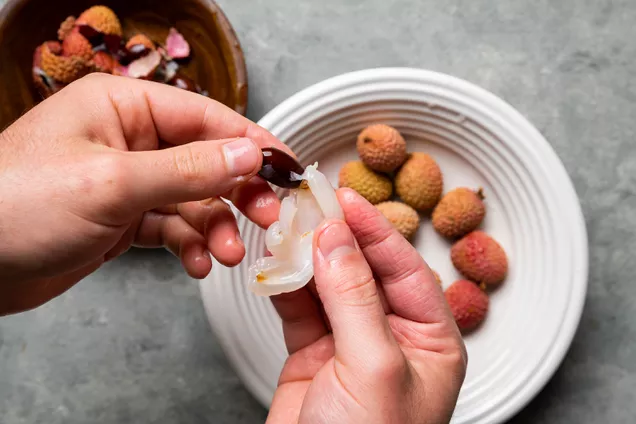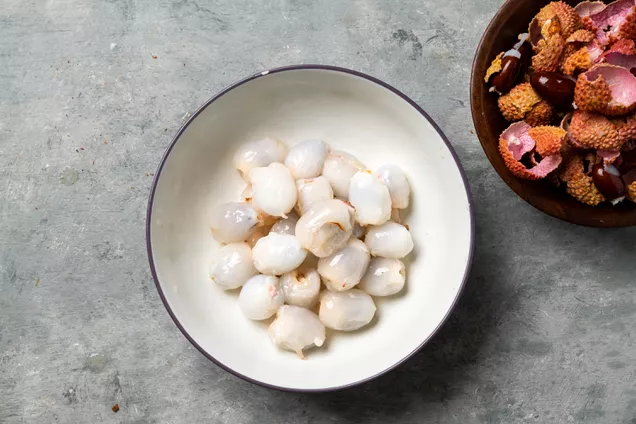
lychee
Lychee is a delicious tropical fruit that can be enjoyed year-round. Sometimes spelled litchi or called alligator strawberry, it’s a fruit that is native to China, but can grow in some parts of the United States. Fresh lychee can usually be found in Asian markets. Underneath the hard, bumpy husk is tender, white flesh with a sweet strawberry-watermelon flavor that covers an inedible stone, which is the fruit’s seed.
Lychee is eaten raw on its own and is an excellent addition to fruit salads, sauces, desserts, and beverages.

lychee
Lychee is a delicious tropical fruit that can be enjoyed year-round. Sometimes spelled litchi or called alligator strawberry, it’s a fruit that is native to China, but can grow in some parts of the United States. Fresh lychee can usually be found in Asian markets. Underneath the hard, bumpy husk is tender, white flesh with a sweet strawberry-watermelon flavor that covers an inedible stone, which is the fruit’s seed.
Lychee is eaten raw on its own and is an excellent addition to fruit salads, sauces, desserts, and beverages.
how to select a lychee
Lychee fruit doesn’t ripen after it’s picked from the tree. It also begins to ferment, so it’s essential that you choose only the freshest fruit and plan to use it within one week. Lychee is typically in season from late spring through early fall.
Whether buying lychee at a market or picking it from a tree, select fruit that is larger than one inch in diameter with bright, vibrantly colored skin. Most lychee skin is red, though some varieties are orange or slightly yellow with a pink hue.
To check for ripeness, gently press on the skin with your thumb. It should give a little. If it’s too soft, it may be overripe. Ripe lychee will have a lush, floral smell. Signs of spoiled lychee include a brown husk or fruit that’s cracked, secreting liquid, or smells fermented or off.
how to select a lychee
Lychee fruit doesn’t ripen after it’s picked from the tree. It also begins to ferment, so it’s essential that you choose only the freshest fruit and plan to use it within one week. Lychee is typically in season from late spring through early fall.
Whether buying lychee at a market or picking it from a tree, select fruit that is larger than one inch in diameter with bright, vibrantly colored skin. Most lychee skin is red, though some varieties are orange or slightly yellow with a pink hue.
To check for ripeness, gently press on the skin with your thumb. It should give a little. If it’s too soft, it may be overripe. Ripe lychee will have a lush, floral smell. Signs of spoiled lychee include a brown husk or fruit that’s cracked, secreting liquid, or smells fermented or off.
How to peel a lychee:
Lychee needs to be peeled and the husk and stone discarded. The seed is slightly poisonous, and only the white flesh is edible. Be gentle because it is a delicate fruit, and work over a bowl to capture any juice.
There’s no need to wash lychee before or after peeling. The husk protects the part that’s eaten and it’s easier to peel off when dry.
How to peel a lychee:
Lychee needs to be peeled and the husk and stone discarded. The seed is slightly poisonous, and only the white flesh is edible. Be gentle because it is a delicate fruit, and work over a bowl to capture any juice.
There’s no need to wash lychee before or after peeling. The husk protects the part that’s eaten and it’s easier to peel off when dry.

- Holding one fruit in your fingers, pierce the bumpy outer skin with your thumbnail.

2. Peel back the skin like you would an orange. It should come off easily in a few pieces if the fruit is ripe.

3. Holding one fruit in your fingers, pierce the bumpy outer skin with your thumbnail.

4. Open up the two halves—the stone should stick to one side, similar to an avocado. Use your finger and thumb to pinch and slightly dig under the stone to remove it. It should slide out easily, but don’t worry if the fruit tears a bit in the process.

- Holding one fruit in your fingers, pierce the bumpy outer skin with your thumbnail.

2. Peel back the skin like you would an orange. It should come off easily in a few pieces if the fruit is ripe.

3. Holding one fruit in your fingers, pierce the bumpy outer skin with your thumbnail.

4. Open up the two halves—the stone should stick to one side, similar to an avocado. Use your finger and thumb to pinch and slightly dig under the stone to remove it. It should slide out easily, but don’t worry if the fruit tears a bit in the process.
How to eat a lychee:

Raw lychee fruit is a delicious and refreshing snack on its own, though there is so much more you can do with fresh lychee. Use the fruit as a focal point to a cheese plate, complete with mild chèvre and cheddar varieties.
Lychee is commonly included in fresh fruit salads along with other tropical fruits. It pairs well with banana, coconut, mango, passion fruit, and pineapple. When used in a similar manner to strawberries, lychee’s an interesting addition to green garden salads as well. You can even add lychee and cashews to oatmeal for a yummy breakfast treat.
In Asian cuisines, lychee fruit or juice is commonly part of a sweet sauce to accompany savory dishes. The fruit may also be included in a stir-fry with sweet and sour sauce. Chicken and fish dishes are popular, and lychee has even found its way into homemade barbecue sauce recipes.
Many desserts and beverages feature lychee. The fruit may be blended into a smoothie or cooked in sweet recipes such as this Thai coconut milk dessert. Quite often, the fruit is used to make a lychee syrup by boiling it with sugar and water. The syrup is an excellent sweetener for cocktails, tea, and other drinks. It’s also fantastic when drizzled over ice cream or sorbet.
How to eat a lychee:

Raw lychee fruit is a delicious and refreshing snack on its own, though there is so much more you can do with fresh lychee. Use the fruit as a focal point to a cheese plate, complete with mild chèvre and cheddar varieties.
Lychee is commonly included in fresh fruit salads along with other tropical fruits. It pairs well with banana, coconut, mango, passion fruit, and pineapple. When used in a similar manner to strawberries, lychee’s an interesting addition to green garden salads as well. You can even add lychee and cashews to oatmeal for a yummy breakfast treat.
In Asian cuisines, lychee fruit or juice is commonly part of a sweet sauce to accompany savory dishes. The fruit may also be included in a stir-fry with sweet and sour sauce. Chicken and fish dishes are popular, and lychee has even found its way into homemade barbecue sauce recipes.
Many desserts and beverages feature lychee. The fruit may be blended into a smoothie or cooked in sweet recipes such as this Thai coconut milk dessert. Quite often, the fruit is used to make a lychee syrup by boiling it with sugar and water. The syrup is an excellent sweetener for cocktails, tea, and other drinks. It’s also fantastic when drizzled over ice cream or sorbet.
The Island Fresh Cafe menu features delicious, locally sourced food items sure to satisfy everyone’s taste. Enjoy the best in local grinds, Hawaiian coffee, local food, fish, burgers, vegan and vegetarian options, and a laid back island vibe. Also check out our fresh fruit and flower selection at our farm stand!
The Island Fresh Cafe menu features delicious, locally sourced food items sure to satisfy everyone’s taste. Enjoy the best in local grinds, Hawaiian coffee, local food, fish, burgers, vegan and vegetarian options, and a laid back island vibe. Also check out our fresh fruit and flower selection at our farm stand!
Thank you for interest in joining our community!
Suscribe with your email and recieve updates for the Island Fresh Café. We will get you know about our island Maui and what’s new at the Café! Discounts, specials and much more!
Thank you for interest in joining our community!
Suscribe with your email and recieve updates for the Island Fresh Café. We will get you know about our island Maui and what’s new at the Café! Discounts, specials and much more!
